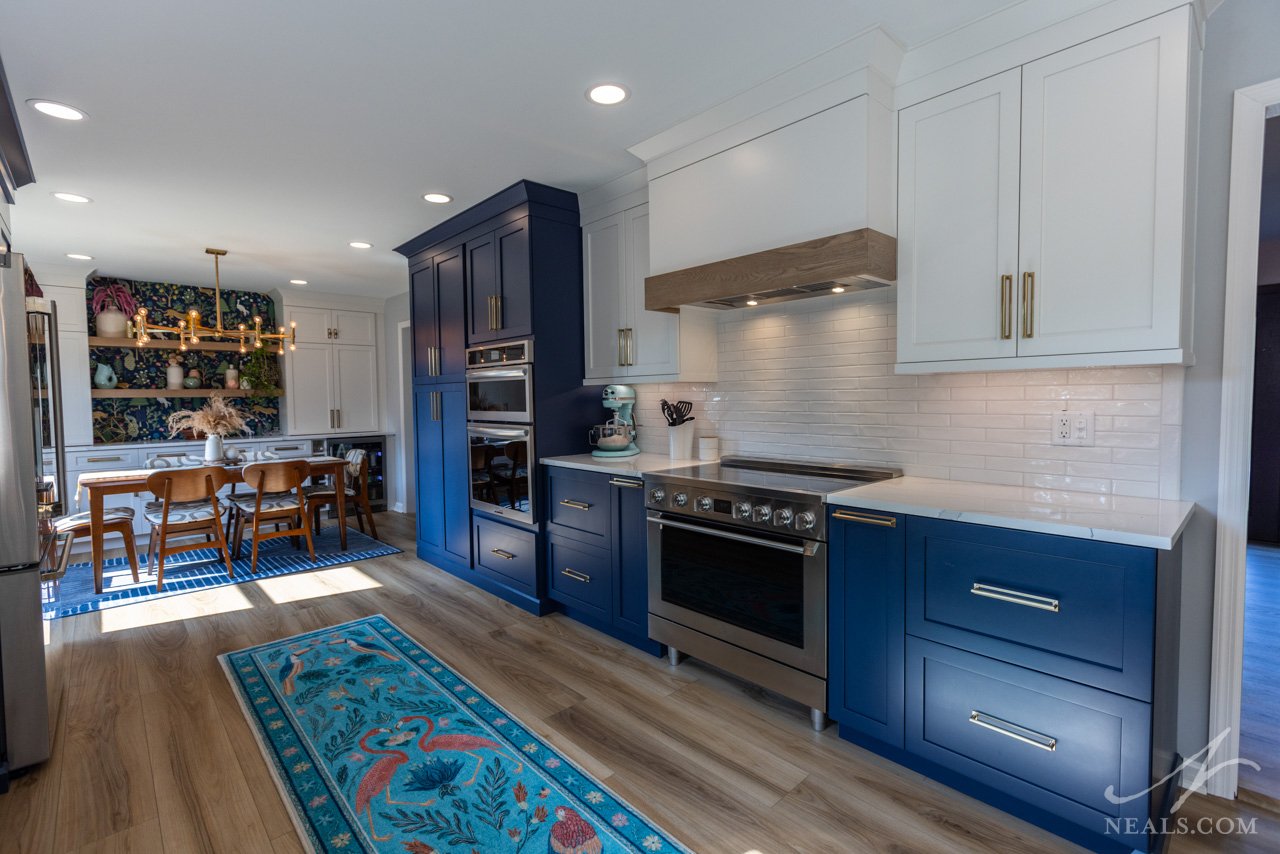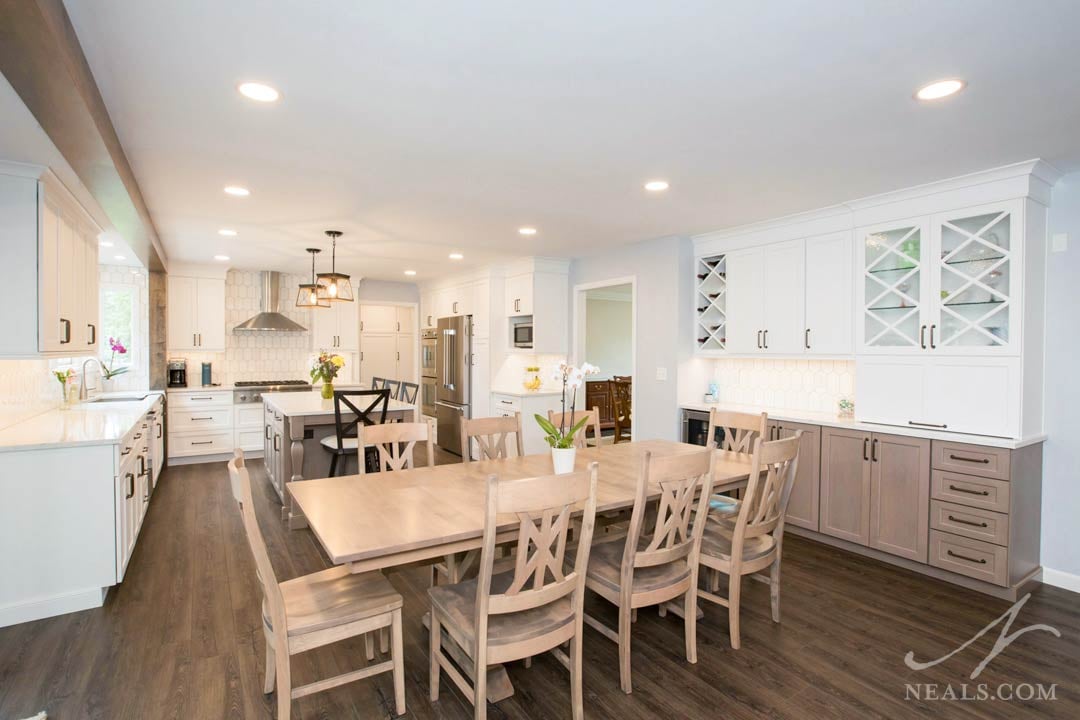Cabinetry is the glue that holds your kitchen together and the solution for most of your storage needs. For that reason, if you’re planning to remodel your kitchen, it’s helpful to get an understanding of the practical considerations you’ll go through with your designer in order to create a functioning cabinetry plan. In this post, we discuss some of the terminology and basic features of kitchen cabinets and provide key ideas for how to handle your storage needs on your kitchen wish list.

Basic Cabinet Categories
There are three categories of cabinets in relation to your kitchen’s floor plan. Base cabinets are the counter height cabinets that sit on the floor and are the only category of cabinets that also work for islands. Wall cabinets are mounted to the wall with open space below, typically positioned above base cabinets. Tall cabinets sit on the floor but go as high as a wall cabinet as one complete unit.
Base Cabinets
The base cabinets are where any drawers are most likely to be used, though some tall cabinets can also have drawers at the bottom. These are typically where the items you need in order to prepare, cook, store, and possibly serve your food go. Towels and other linens, utensils and certain types of pantry food items may potentially go in base cabinets as well.
Wall Cabinets
These cabinets, with their higher positions are also typically not as deep as base cabinets. This makes them ideal for dishes and glasses, as well as dry food storage. Certain types of specialized storage or cooking items may also be stored in wall cabinets for convenience.
Tall Cabinets
The nature of tall cabinets makes them ideal for dry food pantry items, household items such as paper goods or cleaning supplies, or for specialty storage that doesn’t seem to work in base or wall cabinets.
A functional kitchen is likely to utilize all three categories of cabinets but doesn’t have to if your storage needs don’t require all three. Your style preferences may also impact the types of cabinets you would like in your kitchen. For example, you may wish to use open shelving in place of wall cabinets, or to prioritize tall cabinets paired with a large island.

Kitchen Storage Locations
To get the most efficiency in your kitchen, it’s helpful to try to group your storage needs into zones based on the way you want to use your kitchen. The categories that most homeowners will have in their kitchen are items for preparing, cooking, storing, serving, and eating.
You will also have two categories of food to store- dry (non-perishables), and perishable. Though a refrigerator & freezer will handle your perishable items, you may need multiple types of storage locations for the variety of dry food types you keep. You may want to store pantry goods like flour, sugar, and canned foods in one location, but put packaged foods and snacks somewhere else.
In some cases, you may have additional subcategories inside any of these primary storage types. These may be unique to you and your lifestyle. If you entertain, you may have several special party dishes or decorative items in addition to your everyday stuff. Or you may have a large mug collection that needs a dedicated space that puts them on display as well as within reach. Be sure to keep any of these types of extra items in mind as you move forward.
When it comes to planning how your items will relate to your kitchen’s storage plan, you’ll work with your designer to determine how much needs to go in specific locations. Items that belong to the same task should be near each other, but they should also be close to where they will be most used. For instance, your pots and pans should be together near the range, while your washcloths and dish soap should be together near the sink. Be flexible though. A perfect spot for every single thing isn’t always possible.
Your designer will be tasked with figuring out the nuances and specifics, so your job for now, is to just try to narrow down what relative locations seem to work the best for you in a very general sense as you use your kitchen.
As you go through this exercise, think about what category of cabinets (base, wall or tall) might be your preference for the things you use. Also consider if there are items you believe work better in a drawer rather than a cupboard, or vice versa. If you know you would prefer one type of cabinet over another for something specific, making note of that will help when it comes to finding a place for that item. Also, begin to think a little about where and how you may want to use open shelving or glass-fronted cabinet doors. Do you want to be able to see your dishes? Would you like a visible place for your cookbooks?

Sideboards & Wet Bars
Before you get too stuck in the cabinetry available around your new kitchen’s primary working triangle, look at your available space and assess if you would like to add a sideboard or a wet bar.
A sideboard is a perimeter counter with storage below and usually also above, placed separately from your primary working area. It may also be known as a buffet. A sideboard that includes a prep sink and focuses on beverage service is often referred to as a wet bar.
Sideboards and wet bars can include extras like refrigeration units, coffee stations, built-in wine racks, liquor storage, or home communication accessories. They provide supplemental counter and storage space for the items that you need in your kitchen but that you don’t need in the more active working area. They may also provide the chance to include a different design style or cabinetry category than you have elsewhere in the kitchen.
Armed with this better understanding of the items you keep and use in your kitchen you’ll be able to better communicate with your designer about your storage needs and goals. Knowing your preferences for base, wall, and tall cabinets, and how you may want to leverage them within your space can assist your designer with narrowing down a design plan that will be as functional to you as it is beautiful.
If you’re interested in a kitchen remodel but want to learn more about how to start and what you’ll need to understand and determine before your project can begin, use the link below to get our free Homeowner’s Guide to Kitchen Remodeling.











